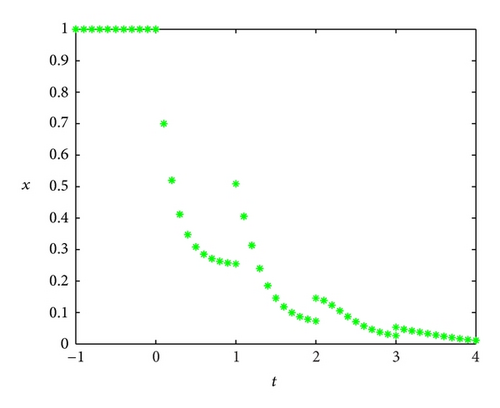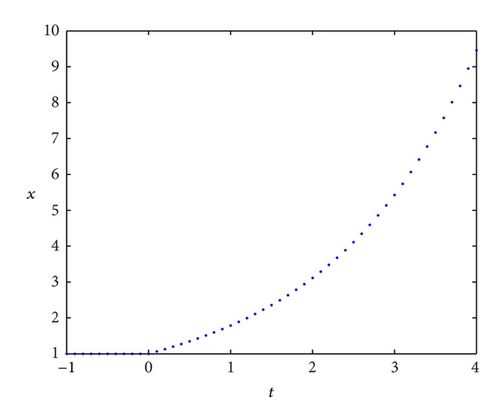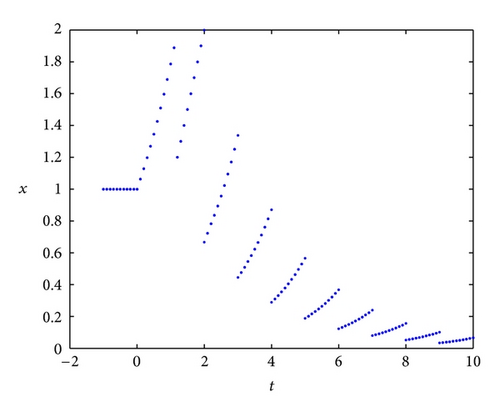Exponential Stability of Impulsive Delay Differential Equations
Abstract
The main objective of this paper is to further investigate the exponential stability of a class of impulsive delay differential equations. Several new criteria for the exponential stability are analytically established based on Razumikhin techniques. Some sufficient conditions, under which a class of linear impulsive delay differential equations are exponentially stable, are also given. An Euler method is applied to this kind of equations and it is shown that the exponential stability is preserved by the numerical process.
1. Introduction
Impulsive differential equations arise widely in the study of medicine, biology, economics, engineering, and so forth. In recent years, theory of impulsive differential delay equations (IDDEs) has been an object of active research (see [1–18] and references therein). The results about the existence and uniqueness of IDDEs have been studied in [2, 7]. The stability of IDDEs has attracted increasing interest in both theoretical research and practical applications (see [1, 3, 5–18] and references therein). In particular, special attention has been focused on exponential stability of IDDEs (see [1, 3, 8, 9, 15]) because it has played an important role in many areas.
There is a little work done on exponential stability for IDDEs by the Lyapunov-Razumikhin method. Wang and Liu [15] have extended Lyapunov-Razumikhin method to IDDEs and established some exponential stability criteria. In this paper we restrict the length of each impulsive interval instead of some conditions in [15]. As a result, several new criteria on exponential stability are analytically derived.
There are a few papers on numerical methods of impulsive differential equations. In [19], Covachev et al. obtained a convergent difference approximation for a nonlinear impulsive ordinary system in a Banach space. In [20, 21], the authors studied the stability of Runge-Kutta methods for linear impulsive ordinary differential equations. In [4], Ding et al. studied the convergence property of an Euler method for IDDEs. In [18], asymptotic stability of numerical solutions and exact solutions of a class of linear IDDEs was studied by the property of DDEs without impulsive perturbations. The convergence of the numerical methods for this kind of equations was studied. In this paper, we study exponential stability of the numerical solutions of linear IDDEs.
The rest of the paper is organized as follows. In Section 2, we obtained two criteria on exponential stability for IDDEs by the Lyapunov-Razumikhin method. The results obtained are applied to a class of linear IDDEs. In the last section, we prove that the Euler method for the linear IDDEs preserves the analytic exponential stability.
2. Stability of Analytic Solutions
Definition 1 (see [15].)A function V: R+ × Rd → R+ is said to belong to the class v0 if
- (i)
V is continuous in each of the sets [tk−1, tk) × Rd and for each x ∈ Rd, t ∈ [tk−1, tk), exists, k = 1,2, …;
- (ii)
V(t, x) is locally Lipschitzian in all x ∈ Rd, and for all t ≥ t0, V(t, 0) ≡ 0.
Definition 2 (see [15].)Given a function V: R+ × Rd → R+, the upper right-hand derivative of V with respect to system (1) is defined by
Definition 3 (see [15].)The zero solution of (1) is said to be exponentially stable, if there exist constants λ > 0 and M ≥ 1, such that for any initial data ,
Theorem 4. Assume that there exist a function V ∈ v0; constants dk > −1, k = 1,2, …; positive constants C1, C2, λ, l1; and a function m(t) ∈ PC ([t0 − τ, ∞), R+) with , such that for any Ψ(t) ∈ PC ([−τ, 0], Rd) with Ψ(0−) = Ψ(0) the following conditions hold:
- (i)
C1∥x∥ ≤ V(t, x) ≤ C2∥x∥ for all t ∈ R+, x ∈ Rd;
- (ii)
D+V(t, Ψ(0))≤−m(t)V(t, Ψ(0)) for all t ∈ [tk, tk+1), whenever for s ∈ [−τ, 0];
- (iii)
for k = 1,2, …;
- (iv)
tk − tk−1 ≥ l1 for k = 1,2, …, and −λl1 + ln H1 < 0, where H1 = sup k{1 + dk}.
Then the zero solution of (1) is exponentially stable.
Proof. Similar to the proof of Theorem 3.1 in [15], we obtain that
Remark 5. Theorem 3.1 in [15] requires that di ≥ 0, and , which implies lim k→∞dk = 0. In our Theorem 4, we require tk − tk−1 ≥ l1 for k = 1,2, …, and instead. This means that the impulsive effects are bounded instead of tending to zero (see Example 13).
Theorem 6. Assume that there exist a function V ∈ v0; constants dk ∈ (−1,0), k = 1,2, …; positive constants l1, l2, C1, C2, λ; and a function m(t) ∈ PC ([t0 − τ, ∞), R+) with , such that for any Ψ(t) ∈ PC ([−τ, 0], Rd) with Ψ(0−) = Ψ(0), the following conditions hold:
- (i)
C1∥x∥ ≤ V(t, x) ≤ C2∥x∥ for all t ∈ R+, x ∈ Rd;
- (ii)
D+V(t, Ψ(0)) ≤ m(t)V(t, Ψ(0)) for all t ∈ [tk, tk+1), k = 1,2, …, whenever V(t, Ψ(0)) ≥ γV(t + s, Ψ(s)) for s ∈ [−τ, 0], where γ is a constant and , H2 = inf k{1 + dk} and q is the smallest integer larger than or equal to τ/l1;
- (iii)
;
- (iv)
l1 ≤ tk − tk−1 ≤ l2 for k = 1,2, …, and , where H1 = sup k{1 + dk}, H2 = inf k{1 + dk}.
Then the zero solution of (1) is exponentially stable.
Proof. Let x(t) = x(t, t0, Φ) be the solution of system (1) and V(t) = V(t, x(t)). We will prove
Let
Next we shall show Q(t) ≤ 0, for t ∈ [t0, t1). Suppose this is not true. Then there is a t* such that t* ≤ inf {t ∈ [t0, t1), Q(t) > 0}, Q(t*) ≤ 0, Q(t*) ≥ (γ − 1)C2∥Φ∥τ, and
Assume that Q(t) ≤ 0, for t ∈ [t0, tm), m ≥ 1. We shall show that Q(t) ≤ 0, for t ∈ [t0, tm+1). Obviously, by condition (iii)
Since , then for any s ∈ [−τ, 0], we have
Remark 7. Theorem 6 says that the delay differential equation is unstable and the suitable impulse effects are given, then it will become stable (see Example 14). Compared with the Theorem 3.1 in [16], we do not require that τ ≤ tk − tk−1. For example, by Theorem 6 we know that the zero solution of the following system is exponentially stable:
In the following we consider
Theorem 8. Assume that ck ≠ −1, k = 1,2, …, and there is a constant λ > 0 such that a+|b | eλτ ≤ −λ and 0 < H1 < eλτ, where H1 = sup k{|1 + ck|}. Then the zero solution of (17) is exponentially stable.
Proof. Assume that V(x) = V(t, x) = |x|.
- (i)
Obviously, there exist C1 = C2 = 1, such that C1 | x | ≤ V(x) ≤ C2 | x|.
- (ii)
Assume that m(t) = λ for all t ≥ −τ. For any Ψ ∈ PC([−τ, 0], R), if
()
- (iii)
Suppose that 1 + dk = |(1 + ck)|. Hence
() - (iv)
Obviously, l1 = τ = tk − tk−1 and −λl1 + ln H1 < 0.
By Theorem 4, the zero solution of (11) is exponentially stable.
Similarly, by Theorem 6 we have the following theorem.
Theorem 9. Assume that 0<|1 + ck | < 1, k = 1,2, …, and there are constants λ and γ such that λ > 0, 0 < γ < H2 ≤ H1 < e−λτ, and a+|b | γ−1 ≤ λ, where H1 = sup k{|1 + ck|}, H2 = inf k{|1 + ck|}. Then the zero solution of (17) is exponentially stable.
3. The Euler Method for Linear IDDEs
Definition 10. The Euler method for (11) is said to be exponentially stable if there exist positive constants λ, M, and M1, for any Φ ∈ PC ([−τ, 0], R), such that ∥xn∥ ≤ M∥Φ∥τe−nλh for h = τ/m, m ≥ M1, and n = 1,2, ….
The following theorem indicates that the Euler method preserves the property of exact solutions which was obtained above.
Proof. If a < 0, then M1 = −aτ. (i) If H1 > 1, we want to prove that
Assume that |x0,p| ≤ ∥Φ∥τe−λph for p < l ≤ m. Then
- (ii)
If H1 ≤ 1, we can prove that
()
Example 13. Consider the system

Example 14. Obviously, the zero solution of the system


Acknowledgments
The authors wish to thank referees for valuable comments. The research was supported by the NSF of China no. 11071050.




